The Panathinaiko Stadium (also Panathenaic Stadium) is a multi-purpose stadium in the centre of Athens. The Arena was the stadium of the first Olympics of modern times in Athens in 1896, so it is an Olympic Stadium. It is one of the most popular sights in Athens among tourists. For 5 Euro entrance fee you can go to the spectator stands, inside the stadium to the running track and through a tunnel to a museum.
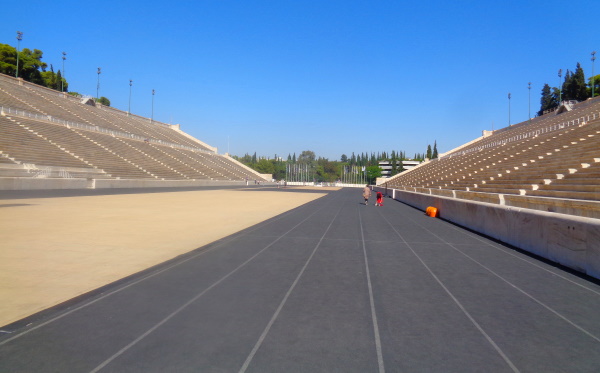
The shape of the Panathinaiko Stadium is different from the shape of modern athletics competition venues. It is longer and less wide. The shape is more reminiscent of a horse race track or a horseshoe. The running track therefore has very narrow curves at both ends. In fact, there was a horse race track at the same place in ancient times. The ancient Olympiads were not in Athens, but in the small town of Olympia in the Peloponnese, about 300 km from Athens.
>>>> Hop-on/hop-off buses for city tours in Athens should be booked online via this link
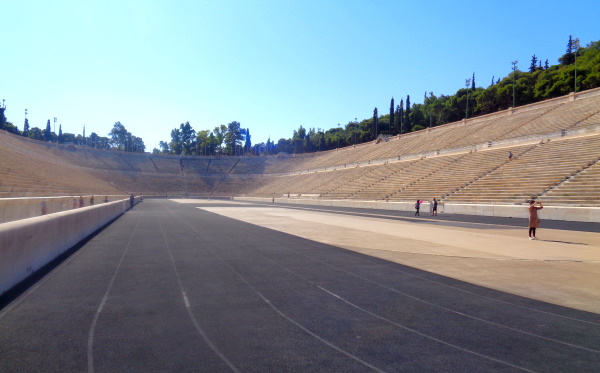
A popular photo motif in the Panathenaic Stadium in Athens is a podium. You can stand on it and someone else takes a photo. You can also enter the running track and run a lap if you want. You can also see the small box of the former royal couple of Greece.
Furthermore, you can go to all spectator seats in the Panathinaiko stadium. There is room for about 50,000 people, so it is a rather large stadium. Due to a large donation, the arena could be built completely out of marble more than 100 years ago. To our knowledge it is still the only stadium in the world made of marble. It looks great. Because of the marble, the Panathenaic Stadium in Greece is often called Kalimarmaro (translated: beautiful marble).
As a visitor of the Panathinaiko you can leave the stadium through an impressive tunnel in the back. After about 100 meters of tunnel you will come to a small museum.
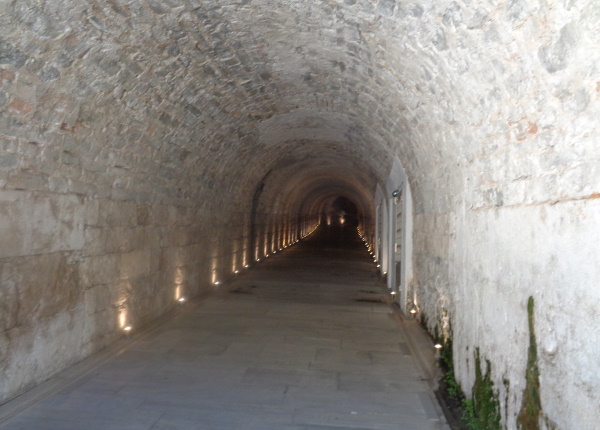
Very interesting in the Panathinaiko Museum we found the mirror with which the Olympic fire is lit. The concave mirror bundles sunlight and generates enormous heat at one point.
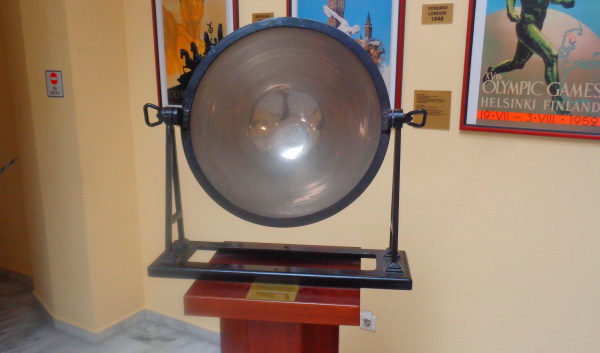
The bowl in which the Olympic flame burns is also on display. A torch for a single nation is also on display. There are about 200 of these at today’s Olympics, one for each participating country.
There is also an advertising poster in the museum of the Panathenaic Stadium for all Olympic Games of modern times since Athens 1896; the picture shows the poster for the Munich Olympics in 1972.
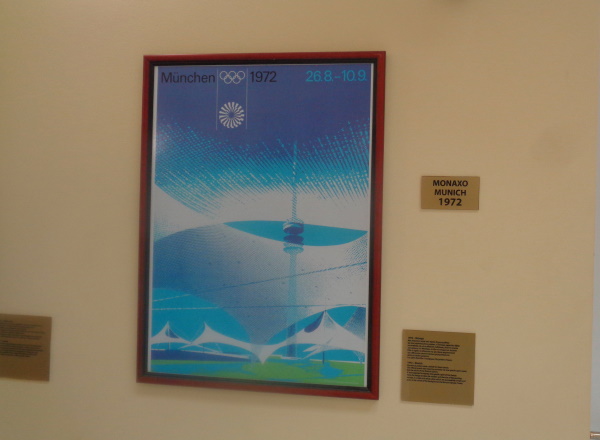
After visiting the museum, you go back into the stadium through the tunnel and out again through the exit. There is a cafe in front of the entrance. There is no water to buy in the stadium, take it with you when it is hot. As far as we know, you can take pictures wherever you want.
Entrance Panathinaiko Stadium Athens: There is only one ticket for everything including the museum. This costs 5 Euro (reduced 2,50 Euro). There is also a free audio guide in many languages including German. A fair entrance fee for such a great sight. We think that every visitor to Athens should visit the old Olympic Stadium Panathenaic Athens.
Opening hours Panathinaiko Stadium Athens: Very long: Every day of the week from 8 am to 7 pm, in winter because of the early darkness only until 5 pm (November to February). Very rare are events in the arena like the Athens Marathon, concerts or sports competitions. Then you cannot visit the old Olympic Stadium Athens. By the way, the stadium of the Olympic Games 2004 in Athens is quite somewhere else, many kilometers outside the center of the Greek capital.
How to get there / location Panathinaiko Stadium: From the central square of Athens Syntagma Square you walk right at the Parliament and a few hundred meters around the National Garden of Athens. Of course you can also walk through the park which is worth seeing, it is probably the most beautiful city park of Greece. Especially in the very noisy city of Athens a great change. Beside the metro station Syntagma the stadium Acropolis is not too far away.
More information about the Panathenaic Stadium
The Panathenaic Stadium, also known as Kalimarmaro, is an ancient stadium in Athens, Greece. It is the only stadium in the world built entirely of marble and is considered one of the most famous sporting venues in history.
History: The Panathenaic Stadium has a rich history dating back to ancient Greece. The stadium was originally built in the 4th century BC for the Panathenaic Games, which were held every four years in honor of the goddess Athena. These games included various sporting events such as foot races, wrestling, boxing, and chariot racing. The stadium was rebuilt in the 2nd century AD by Herodes Atticus, a wealthy Greek nobleman and philanthropist. Atticus, known for his love of art and culture, wanted to restore the stadium to its former glory. He added several features to the stadium, including stone seating areas, marble entrances, and covered colonnades.
Over the following centuries, the Panathenaic Stadium fell into disrepair and was eventually abandoned. However, when it was rediscovered in the 19th century by the Greek architect Dimitrios Zezos, he recognized its historical significance and began its restoration. In 1869, the Greek government commissioned the French architect Ernest Evrard to restore the stadium. Evrard worked tirelessly with a team of Greek architects and engineers to breathe new life into the stadium. They added new features, such as the royal box and marble arches, and restored the seating and athletics track to their original splendor.
Modern Use: The Panathenaic Stadium has been used for various events throughout history. It hosted the first modern Olympic Games, held in Athens in 1896. The stadium was chosen for its historical significance and its ability to accommodate large crowds.
Since then, the stadium has been used for various sporting events. The classic Athens Marathon, for example, starts in the city of Marathon and ends at the Panathenaic Stadium. It has also been used for cultural events such as concerts and plays.
Visiting the Panathenaic Stadium: The Panathenaic Stadium is now open to the public and is a popular tourist attraction. Visitors can take guided tours of the stadium and learn more about its history and significance. Tours include visits to the seating area, the running track, the royal box, and the display of the Olympic torch and memorabilia. Visitors can also take a lap of the running track, which is popular with tourists and locals alike.
What does Panathenaic mean?
The term Panathenaic is derived from the Greek “pan-” (πᾶν), meaning “all” or “whole,” and “Athinaiko,” referring to Athens. Overall, it can be translated as “pertaining to all Athens” or “exclusively Athens.”
Examples:
Panathinaiko Stadium: The stadium in Athens that represents or is intended for all Athenians.
Panathinaiko Festival: A festival celebrating the entire Athenian community.
The term is therefore used to characterize something as typically, entirely, or collectively Athenian.
When was the Panathinaiko Stadium built?
The Panathinaiko Stadium has a fascinating history that can be divided into two main phases:
Ancient:
Originally built in the 4th century BC to host the Panathenaia—the festivals honoring the goddess Athena. This complex served as a venue for athletic competitions and other celebratory activities.
Modern:
For the first modern Olympic Games, the stadium was extensively restored in 1896 and recreated in its present form. The original, monumental character was preserved, making it the only stadium in the world made entirely of marble.
How big is the Panathenaic Stadium?
The Panathenaic Stadium – also known as Kallimarmaro – is oval in shape with a circumference of approximately 204 meters. In ancient times, it could accommodate around 50,000 spectators, while today it can accommodate approximately 20,000 visitors for events.